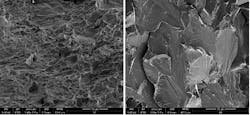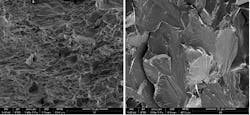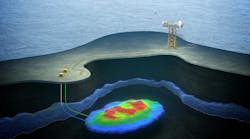C.L. Walters, W. Duvalois
TNO
M. Bruchhausen, J-M. Lapetite
European Commission Joint Research Centre
Researchers at TNO, the Dutch organization for applied scientific research, are working on a method for testing how safe offshore structures are against failure without having to destroy the structure to prove it. This is because assessments needed to check the safety of a structure, such as BS 7910: Guide to methods for assessing the acceptability of flaws in metallic structures, require destructive testing of specimens. While not a problem for new structures, it can result in expensive repairs for existing offshore structures.
The nuclear industry has developed a test method, available at the EU Joint Research Centre (JRC) in Petten, the Netherlands, which requires only very small samples of the structure to be extracted by a device that could be described as a special type of ice-cream scoop. Over the next few years, TNO plans to devise an analysis method to convert the results from this minimally destructive method into numbers that can be used to assess the safety of offshore structures by standard methods. This should increase the accuracy of assessing the remaining service life of structures, whether old structures whose service life is being extended, new structures that need to be re-assessed due to new information, or existing structures being used in a new situation.
In the nuclear industry, structural integrity is heavily researched because the material properties of steel are known to change as a result of neutron irradiation. Therefore, engineers need to monitor the toughness of their structures in order to check whether the structure is safe or not. This involves placing extra material in the reactor that can be removed for Charpy testing, which assesses the toughness of a material by striking a notched specimen with a hammer and measuring how much energy is absorbed. However, as the sacrificial material is used up, smaller specimens are needed. For this reason, the nuclear industry has created the small punch test (SPT).
A very small specimen is punched perpendicular to its surface until the specimen - a disk 8 mm in diameter by 0.5 mm thick - fails. The force versus displacement is measured, and brittle failure is characterized by a sudden drop in force. As with Charpy testing, the SPT features a change from safe, ductile behavior at higher temperatures to a brittle, unsafe behavior at lower temperatures. The temperature at which this transition occurs is known as the Ductile to Brittle Transition Temperature (DBTT).
While both the Charpy test and SPT feature a DBTT, it is different for both tests. Empirical relationships already exist between SPT results and the Charpy DBTT. However, the derived empirical correlations are unlikely to accurately predict the behavior of offshore steels (different from those used in the nuclear industry) without further development or validation. Furthermore, the state of stress in a SPT is different from that of typical Charpy specimens, so there was concern that the SPT would not reproduce the brittle fracture mechanism in offshore steels.
Experiments were therefore staged to see whether the SPT works for offshore steels, using a sample of commercially available S355J2+N steel. SPT tests were performed at the JRC in Petten, while Charpy and Crack Tip Opening Displacement (CTOD) tests were conducted in a commercial laboratory under contract from TNO. Initial test results showed that the S355 steel behaved differently from the nuclear steels that JRC typically tested.
However, the S355 nevertheless displayed a ductile to brittle transition, marked by three distinguishing features:
- The force in the cold specimens suddenly dropped upon fracture
- The relationship between the indentation energy and the temperature features two distinct regions - one at high temperature, and the other at low temperature
- Fracture surfaces showed a characteristic dimpling for ductile failure and a facetted surface for brittle failure.
All three of these features show that the SPT can identify ductile to brittle behavior in this steel and that brittle failure can be measured.
Since the 1980s, researchers have shown that the probability of brittle failure depends on the first principal stress and the volume over which it is applied. Furthermore, steel has a higher strength at lower temperatures, and the latter tend to increase the first principal stress in a material test. Therefore, analytical methods must allow for trading between temperature, the first principal stress in a material, and the volume of stressed material. It follows there is a trade-off between high local stresses and lower temperatures, so testing methods with high local stresses will have a higher DBTT and vice versa.
There is a promising future for fracture testing of existing steel offshore structures without damaging them. This will help to justify longer service lives of offshore assets or the use of structures beyond their original design environment (i.e. those transferred to new applications in the arctic). The JRC’s new tests have confirmed that these techniques can produce brittle failure in steels relevant to the offshore industry, which is critical for characterizing the most relevant fracture mechanism in the offshore industry.






